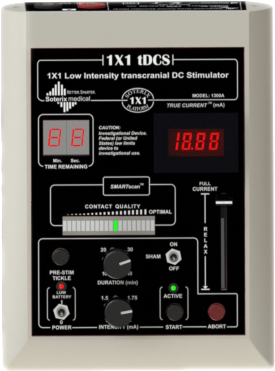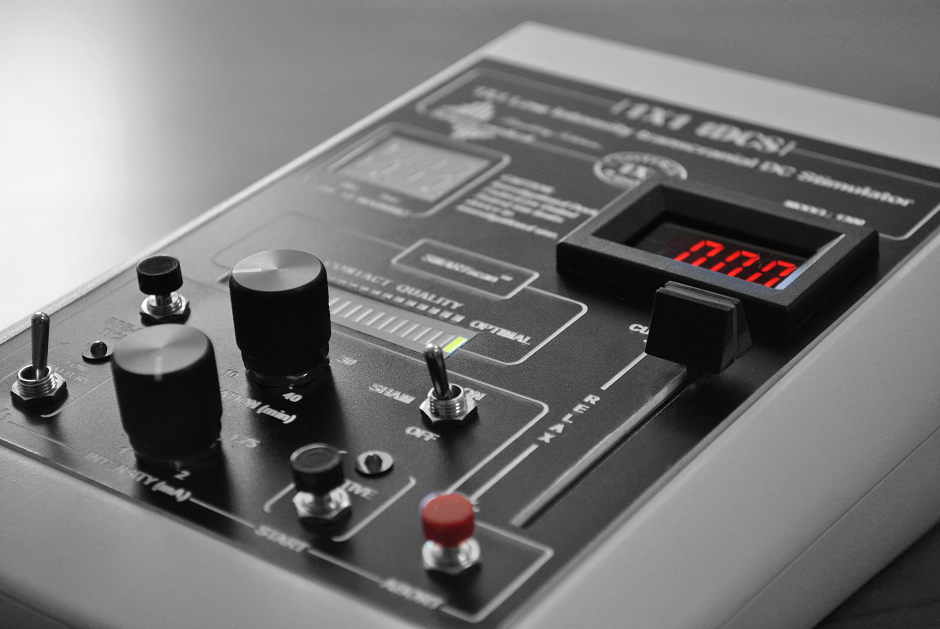
The Soterix Medical 1×1 transcranial Direct Current Stimulation (tDCS) is the clinical standard device when precision and safety cannot be compromised. The Open-Panel™ control panel allows simple set-up and monitoring. Exclusive features including SmartScan™, RELAX™, and TrueCurrent™ ensure every run is successful.
What is tDCS?
Transcranial Direct Current Stimulation (tDCS) is a non-invasive procedure in which a device sends a small Direct Current (DC) across the scalp to modulate brain function. When the extremely low level current passes from the anode to the cathode, it may simultaneously increase the activity of the brain by the anode and decrease the activity of the brain near the cathode. tDCS mechanisms are considered to result from the ability of very weak DC currents to safely induce reversible changes in cortical plasticity. The induction of lasting changes in cortical excitability can, under some conditions, reversibly modify behavior and interact with normal learning. Such findings have driven a large number of studies examining whether tDCS might induce functionally significant changes in patients with a large variety of neurological and psychiatric disorders. tDCS dose can be defined as: 1) The size and position of the electrodes on the body and 2) The duration (in minutes) and intensity (in mA) of current passed across the electrodes.

Industry Standard For Clinical Trials
The Soterix Medical 1×1 was developed by clinical researchers, scientists, and biomedical engineers to provide all clinical standard tDCS protocols. Current intensity from 0.5 to 2 mA, and current duration from 5 to 40 minutes. Stimulation set-up is straight-forward with the simple to set-up Open-Panel™ controls, 1×1 electrode accessories, and SmartScan™ indicator. The tDCS 1×1 features allow you to focus on the subject and experiment, not the device.

Stimulation precision and control
The Soterix Medical 1×1 platform is the most accurate tDCS technology available. Built into every 1×1 device are the most advanced monitoring and control systems updating performance and feedback over 1000 times per second. Stimulation output fidelity (signal-to-noise) is maintained during the entire stimulation session even if electrode conditions change. Precise control of output waveform is essential for stimulation efficacy and safety. Clinical trials with Soterix Medical 1×1 tDCS remove uncertainty about device output and ensure results are meaningful and reproducible.

Simple to use Open-Panel™
In developing the 1×1, feed-back from leading clinical centers was clear: tDCS must be simple to program and stimulation status must always be apparent to the investigator. With easy-click control knobs to set stimulation duration and intensity, and back-lit status displays visible in dim or bright room light, the Soterix Medical Open-Panel™ design takes the guess work out of tDCS. No drop-down menus. No hidden settings. No external computer. Design for simple and clear clinical trials with Soterix Medical Open-Panel™.
Compatibility with monitoring technology
With increased interest in the use of monitoring, such as EEG, PET, MEG, Eye-tracking, NIR and fMRI in conjunction with tDCS, Soterix Medical remains the only company with the technology and expertise to ensure successful integration. Stimulation generates artifacts in all monitoring modalities including fMRI (Antal A et. al 2012), such that use of technically compatible devices without also integrating rational trial design, can lead to errant findings.
Soterix Medical biomedical engineers are available to discuss the combination of rational measurement with our industry standard 1×1 platform. And only Soterix Neurotargeting allows co-registration of current flow and measured responses
Imaging artifacts induced by electrical stimulation during conventional fMRI of the brain. Antal A, Bikson M, Datta A, Lafon B, Dechent P,Parra LC, Paulus W
Learn more about Soterix Medical 1×1 tDCS device, please click https://soterixmedical.com/research/1×1/tdcs or reach us here.
